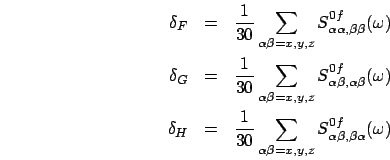




Next: Ground state-excited state three-photon
Up: Coupled-cluster calculations, CC
Previous: Ground state-excited state transition
Contents
Index
Ground state-excited state two-photon transition moments:
*CCTPA
This section describes the calculation of
two-photon absorption strengths
through coupled cluster response theory.
The two-photon transition strength is defined as
*CCTPA drives the calculation of the left (
 )
and right (
)
and right (
 ) transition moments, and of the
(diagonal) transition strengths
) transition moments, and of the
(diagonal) transition strengths
 .
The methodology is implemented for the CCS, CC2, CCSD and CC3 models.
.
The methodology is implemented for the CCS, CC2, CCSD and CC3 models.
![\fbox{
\parbox[h][\height][l]{12cm}{
\small
\noindent
{\bf Reference literature:...
...wblock {\em J.~Chem.~Phys.}, {\bf 108},\hspace{0.25em}8355, (1998).
\end{list}}}](img385.png)
- .STATES
READ (LUCMD,'(A70)') LABHELP
DO WHILE (LABHELP(1:1).NE.'.' .AND. LABHELP(1:1).NE.'*')
READ (LUCMD,'(3A)') IXSYM, IXSTATE, SMFREQ
END DO
Select one or more excited states (among those specified
in *CCEXCI), and photon energies.
The symmetry class (IXSYM) and the number a state  within that symmetry (
within that symmetry (IXSTATE) have to be given
together with a photon energy 
SMFREQ (in atomic units).
For each state and photon energy the moments
 and
and
 and the
strengths
and the
strengths
 are computed for all operator pairs.
Instead of .STATES the equivalent keywords .TRANSITION,
.SELEXC, or .SELSTA may be used.
are computed for all operator pairs.
Instead of .STATES the equivalent keywords .TRANSITION,
.SELEXC, or .SELSTA may be used.
- .HALFFR
- Set the photon energies (frequencies) for the two-photon transition moments
equal to half the excitation energy of the final state
 as calculated with the present coupled cluster model.
If this option is switched on, the photon energies given with the
specification of the states (.STATES) will be ignored.
as calculated with the present coupled cluster model.
If this option is switched on, the photon energies given with the
specification of the states (.STATES) will be ignored.
- .OPERAT
READ (LUCMD,'(4A)') LABELA, LABELB
DO WHILE (LABELA(1:1).NE.'.' .AND. LABELA(1:1).NE.'*')
READ (LUCMD,'(4A)') LABELA, LABELB
END DO
Read pairs of operator labels.
For each pair the left and right two-photon transition moments
and strengths
 will be evaluated
for all states and frequencies.
Operator pairs which do not correspond to symmetry allowed
combinations will be ignored during the calculation.
will be evaluated
for all states and frequencies.
Operator pairs which do not correspond to symmetry allowed
combinations will be ignored during the calculation.
- .DIPLEN
- Compute all symmetry-allowed elements of the dipole-dipole
transition moment tensors in the length gauge
and the corresponding transition strengths.
In addition the three averages
 ,
,  , and
, and  are evaluated (see below).
are evaluated (see below).
- .DIPVEL
- Compute all symmetry-allowed elements of the dipole-dipole
transition moment tensors in the velocity gauge
and the corresponding transition strengths.
- .ANGMOM
- Compute all symmetry-allowed elements of
the transition moment tensors
with the operators
 and
and  equal to
a component of the angular momentum operator
equal to
a component of the angular momentum operator  ,
which is proportional to the magnetic dipole operator.
,
which is proportional to the magnetic dipole operator.
- .PRINT
READ (LUCMD,*) IPRSM
Read print level. Default is 0.
- .USE X2
- use the second-order vectors
 as intermediates.
This may save some CPU time with the models CCS, CC2, and CCSD.
It will be ignored in CC3 calculations, where it cannot be used.
as intermediates.
This may save some CPU time with the models CCS, CC2, and CCSD.
It will be ignored in CC3 calculations, where it cannot be used.
- .USE O2
- use the second-order vectors
 as intermediates.
This may save some CPU time with the models CCS, CC2, and CCSD.
It will be ignored in CC3 calculations, where it cannot be used.
as intermediates.
This may save some CPU time with the models CCS, CC2, and CCSD.
It will be ignored in CC3 calculations, where it cannot be used.
If no transitions have been specified using .STATES or one
of the equivalent keywords, the default is to include all
states specified in *CCEXCI with the photon energies
set to half the excitation energies
(i.e. the .HALFFR option is implied).
If the full dipole-dipole tensors (in length gauge) have been specified for the
moments (e.g. using .DIPLEN), the following three isotropic averages will be
evaluated:
The option .DIPLEN will be implied by default if no other
operator pairs have been specified using one of the keywords
.OPERAT, .DIPVEL, or .ANGMOM.





Next: Ground state-excited state three-photon
Up: Coupled-cluster calculations, CC
Previous: Ground state-excited state transition
Contents
Index
Dalton Manual - Release 1.2.1
 .
The methodology is implemented for the CCS, CC2, CCSD and CC3 models.
.
The methodology is implemented for the CCS, CC2, CCSD and CC3 models.
 are computed for all operator pairs.
Instead of .STATES the equivalent keywords .TRANSITION,
.SELEXC, or .SELSTA may be used.
are computed for all operator pairs.
Instead of .STATES the equivalent keywords .TRANSITION,
.SELEXC, or .SELSTA may be used.
 will be evaluated
for all states and frequencies.
Operator pairs which do not correspond to symmetry allowed
combinations will be ignored during the calculation.
will be evaluated
for all states and frequencies.
Operator pairs which do not correspond to symmetry allowed
combinations will be ignored during the calculation.
 as intermediates.
This may save some CPU time with the models CCS, CC2, and CCSD.
It will be ignored in CC3 calculations, where it cannot be used.
as intermediates.
This may save some CPU time with the models CCS, CC2, and CCSD.
It will be ignored in CC3 calculations, where it cannot be used.